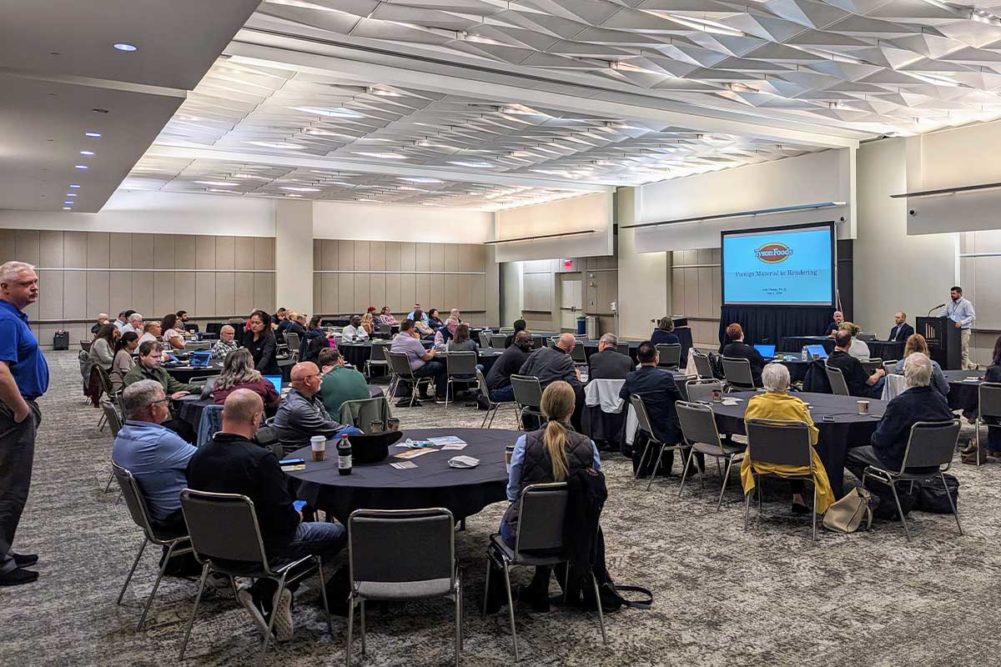KANSAS CITY, MO. — Roughly 80 experts spanning the pet food and rendering industries and related academia convened in Kansas City for the 2024 Pet Food Alliance Technical Meeting, held May 1 and 2 at the Kansas City Convention Center. As in years past, attendees came together with a common goal: to collaborate on key issues facing the pet food and rendering sectors and fund research into their solutions.
Pet Food Alliance is sponsored by the Fats and Protein Research Foundation (FPRF) and Colorado State University (CSU) and is organized in large part by Jennifer Martin, Ph.D., assistant professor in the Department of Animal Science’s Center for Meat Safety and Quality at CSU.
This year’s meeting commenced with working group collaborations and a cocktail reception on Wednesday, May 1. The following day, members convened back at the Kansas City Convention Center bright and early for just under a day of educational and collaborative programming.
The agenda this year centered around three key topics: foreign materials, workforce and educational gaps that exist in the pet food and rendering industries, and continuing efforts for each of Pet Food Alliance’s three working groups.
Three industry professionals — Billy Voelkel, director of food safety and quality for General Mills’ Blue Buffalo division; Josh Hasty, Ph.D., director of research and development for Tyson Foods’ Ingredient Solutions Group; and Austin Therrell, executive director of the Association of American Feed Control Officials (AAFCO) — kicked off the meeting with a panel on foreign material contamination. The panel was moderated by Tammy Hogan, senior quality manager at General Mills for Blue Buffalo.
Throughout the panel, participants and audience members discussed how suppliers and processors can work together to improve the language, testing and reporting of foreign materials in rendering and pet food operations. This includes financial collaboration and alignment of sustainability goals and expectations between the supplier and processor, as well as overcoming existing regulatory and veterinary knowledge gaps.
 Source: Sosland Publishing Co. / Jordan Tyler
Source: Sosland Publishing Co. / Jordan TylerMartin took the stage next to discuss how changing workforce demographics are creating skill gaps in manufacturing, including rendering and pet food processing. According to data from multiple sources, high turnover in these jobs is creating holes where knowledge is not being passed down as older workers retire, and technological advancements in processing require that the average employee has more skills today than ever before. The industry will need to address these trends today in order to avoid what Martin described as “a dumpster fire” future for the pet food manufacturing workforce.
Before breaking into working groups for the afternoon, Valentina Trinetta, Ph.D., associate professor at Kansas State University in the field of food microbiology, shared an update on recent research studying different ways to mitigate the presence of pathogens and biofilms in pet food manufacturing environments.
At the end of the meeting, leaders from each working group were asked to share progress toward each group’s respective goals. The three working groups — product safety, product quality, and consumer perception and sustainability — have been collaborating for years and were originally assembled to identify and address key challenges facing both pet food and rendering industries. This also includes identifying research opportunities to support each group’s focus.
 Source: Sosland Publishing Co. / Jordan Tyler
Source: Sosland Publishing Co. / Jordan TylerThe product safety group has been working on optimizing and standardizing tank wash practices, specifically moving away from prescriptive steps to a more solutions-oriented approach. Members of the group have put together educational materials to be shared on the Pet Food Alliance website — which is currently undergoing a makeover and will be relaunched soon — and continues to work on aligning the industry around prohibited items, setting minimum expectations for wash tickets, and providing more flexibility for smaller wash facilities.
The product quality group continues to work toward standardizing peroxide value methods used to measure oxidation in fat and protein meals. The group has identified research opportunities that will hopefully support a unified decision in peroxide value methodology in the future.
The consumer perception and sustainability working group has its sights set on reeducating industry members, the veterinary community and consumers about rendered protein meals in pet food. This reeducation involves creating educational content for veterinary, retail and consumer platforms, and disseminating that content via events, podcasts and other platforms.
Details regarding the 2025 Pet Food Alliance meeting are forthcoming. Stay tuned through Pet Food Processing and the Pet Food Alliance website about dates and registration information for future Pet Food Alliance meetings.
Read more about pet food and treat industry events.




